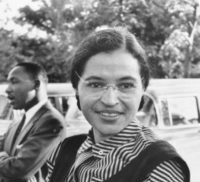We celebrate the birthday of Rosa Parks, known as “the mother of the civil rights movement,” on Feb. 4. She was born as Rosa Louise McCauley in Tuskegee, Alabama in 1913. After her parents separated, Parks went with her mother to live with her grandparents at the age of two. Her grandparents were both former slaves, and therefore, strongly supported civil rights.
Parks’s family found education very important, as her mother was a teacher. Parks, however, was forced to attend segregated schools, where they did not often have necessary supplies, including desks.
The family moved to Montgomery, Alabama when Parks was 11-years-old. During the eleventh grade, Parks had to drop out to help care for her grandmother and later her mother as well. In 1933, Parks was able to go on and earn her diploma with the support of her husband, Raymond Parks, whom she married at the age of 19 in 1932. Raymond Parks was a member of the NAACP. Parks became a member of the organization herself in 1943 and served as a secretary for her local chapter.
In that same year, Parks had her first encounter with bus driver James Blake. During that time, buses were required to be segregated with white people riding in the front half and black people riding in the back. Blacks were also required to pay at the front of the bus, but then had to get off to enter in the back door. Parks decided to stand against this and refused to re-enter the bus from the back. As a response, Blake refused to let Parks ride the bus at all.
On Dec. 1, 1955, Parks took the action that made her a recognizable figure in the fight for racial equality forever. The bus that Parks was riding on started to fill up, causing white passengers to have to stand during the ride. When this happened, the drivers would normally ask a black person to give up his or her seat to the standing riders. Blake was again the driver during this instance and asked Parks to stand up. Parks, however, refused to do so. When Blake asked her why she did not give up her seat, Parks responded with, “I don’t think I should have to stand up.” She was then arrested after Blake called the police. Four days later, Parks was charged as guilty of violating segregation laws. She had to pay a fine of $10 as well as $4 for court fees.
“People always say that I didn’t give up my seat because I was tired, but that isn’t true. I was not tired physically… No, the only tired I was, was tired of giving in.”
-Rosa Parks in her autobiography
Parks’s bravery had a huge impact on the black community around her. Her act inspired the Montgomery Bus Boycott, where many of those oppressed boycotted the bus system and instead found other means to travel. This began on the day of Parks’s trial and lasted 381 days. This action led to a ruling by the Supreme Court that removed the enforcement of bus segregation.
Click here to read about Dr. Martin Luther King Jr. and the Montgomery Bus Boycott.
Life was hard for Parks after the events of her arrest and the boycott. She lost her department store job and faced harsh treatment. Her husband also lost his job because he refused to keep quiet about his wife and the occurrences involving her. Parks was also arrested a second time as she played a part in organizing the boycott, which was against the Alabama law. She and her husband eventually moved to Detroit, Michigan.
Parks continued to show her support for the equal rights movement throughout her life. She received the Congressional Gold Medal from the United States in 1999. Parks died on October 24, 2005 when she was 92-years-old. She was laid in honor at the United States Capitol and became the first woman to do so.
Rebekah Davidson
Intern


